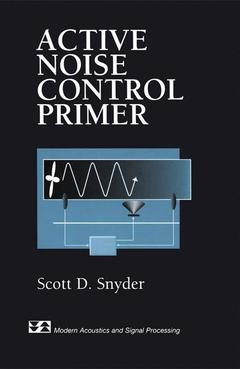Description
Active Noise Control Primer, Softcover reprint of the original 1st ed. 2000
Modern Acoustics and Signal Processing Series
Language: English
Subject for Active Noise Control Primer:
Keywords
Fourier analysis; Vibration; acoustics; algorithm; basics; filters; noise; noise control; signal processing; sound
Active Noise Control Primer
Publication date: 09-2012
159 p. · 15.5x23.5 cm · Paperback
Publication date: 09-2012
159 p. · 15.5x23.5 cm · Paperback
Active noise control primer - POD
Publication date: 05-2000
159 p. · 15.5x23.5 cm · Hardback
Publication date: 05-2000
159 p. · 15.5x23.5 cm · Hardback
Description
/li>Contents
/li>
Active noise control - the reduction of noise by generating an acoustic signal that actively interferes with the noise - has become an active area of basic research and engineering applications. The aim of this book is to present all of the basic knowledge one needs for assessing how useful active noise control will be for a given problem and then to provide some guidance for designing, setting up, and tuning an active noise-control system. Written for students who have no prior knowledge of acoustics, signal processing, or noise control but who do have a reasonable grasp of basic physics and mathematics, the book is short and descriptive. It leaves for more advanced texts or research monographs all mathematical details and proofs concerning vibrations, signal processing and the like. The book can thus be used in independent study, in a classroom with laboratories, or in conjunction with a kit for experiment or demonstration. Topics covered include: basic acoustics; human perception and sound; sound intensity and related concepts; fundamentals of passive noise-control strategies; basics of digital systems; basics of adaptive controllers; and active noise control systems.
1. Introduction.- Welcome to the World of Active Noise Control!.- Summary.- Do I Have to Read the Whole Book?.- What Is Active Noise Control?.- Adaptive Feedforward Active Control Noise.- Advanced Reading.- 2. Background: Fundamentals of Sound.- What Is Sound?.- What Is Noise?.- Quantifying Sound Levels.- Sound Waves.- Frequency Analysis.- Sine Waves.- Fourier Analysis.- Harmonics.- Human Perception of Sound.- Acceptable Sound Levels.- 3. Fundamentals of Noise Control.- Prerequisite Discussion: Power and Impedance.- The Magnitude of Acoustic Power.- Decibel Units for Acoustic Power.- Power, Pressure, and Hearing Loss.- Real and Imaginary Impedancec.- What Is Noise Control?.- What Is Passive Noise Control.- What is Active Noise Control?.- 4. Free Space Noise Control.- Passive Noise Control Approaches.- Control Control Approaches.- 5. Enclosed Space Noise Control.- Where Does the Sound Come From?.- How Does the Sound Get Out Again?.- How Does the Sound Field Arrange Itself?.- Passive Noise Control Approaches.- Active Noise Control Approaches.- 6. Control of Sound Propagation in Ducts.- Sound Fields in Ducts.- Modes in Ducts.- Impedance in Ducts.- Passive Noise Control Approaches.- Sidebranch Resonator.- Expansion Chamber.- Helmholtz Filter.- Dissipative Passive Control Techniques.- Active Noise Control Approaches.- Reference and Error Signal Quality.- Reference Sensor/Control Source Separation Distance.- Control Source Position in the Duct.- Duct Response Characteristics.- 7. Active Noise Controller Overview.- Some Important Facts.- Digital System Requirements.- Controller Output (Digital Control Filter) Requirements.- Adaptive Algorithm Requirements.- 8. Controller Fundamentals.- General Control System Outlines and Definitions.- Physical System Limitations.- Interfacinga Digital System.- Background.- Required Additions for Digital Control.- Overview of the Controller.- Controller Component 1: The Digital Filter.- Controller Component 2: The Adaptive Algorithm.- Controller Component 3: Cancellation Path Modeler.
© 2024 LAVOISIER S.A.S.




